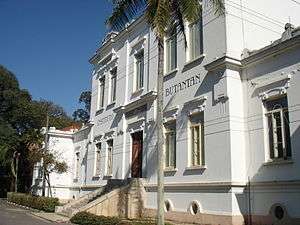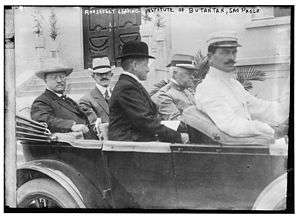Instituto Butantan
Instituto Butantan (in modern Portuguese, Instituto Butantã,[1] pronounced [ĩʃtʃiˈtutu butɐ̃ˈtɐ̃]) is a Brazilian biologic research center located in Butantã, in the western part of the city of São Paulo, Brazil. Instituto Butantan is a public institution affiliated with the São Paulo State Secretariat of Health and considered one of the major scientific centers in the world.[2] Butantan is the largest immunobiologicals and biopharmaceuticals producer in Latin America (and one of the largest in the world). It is world-renowned for its collection of venomous snakes, as well as those of venomous lizards, spiders, insects and scorpions. By extracting the reptiles' and insects' venoms, the Institute develops antivenoms and medicines against many diseases, which include tuberculosis, rabies, tetanus and diphtheria.
 Instituto Butantan | |
| Established | 23 February 1901 |
|---|---|
| Location | Brazil |
| Coordinates | 23°34′S 46°43′W |
| Website | www |
 Location of Instituto Butantan | |

History
The Institute was founded by the Brazilian physician and biomedical scientist Vital Brazil in 1901, according to Pasteur Institute paradigm, i.e., by combining in the same institution medical research, the transfer of the results to society as health products, and self-financing through this later activity. Its foundation was a reaction to the outbreak of bubonic plague in the city of Santos.[3] It is internationally renowned for its research on venomous animals; it was visited by Theodore Roosevelt in 1912. It is also a state-supported producer of vaccines against many infectious diseases, such as rabies, hepatitis, botulism, tetanus, diphtheria, pertussis and tuberculosis, as well as polyvalent and monovalent antivenoms against the bites of snakes, lizards, bees, scorpions and spiders (which, historically were first developed in the beginning of the 20th century by Dr. Vital Brazil and his coworkers). Among the distinguished scientists at the institute were biochemists Karl Slotta and Heinz Fraenkel-Conrat, pioneers in the study of progesterone, estriol, and medical use of venom, from 1935 to 1948.
A fire in 2010 destroyed the collection facility, which maintained one of the largest collections of venomous animals in the world, comprising around 80,000 snake specimens, and an estimated 450,000 spiders and scorpions.[3]
The name of the institute comes from "Butantã",[1] a district in the west zone of São Paulo. "Butantã" itself is a Tupi word[1] meaning "crushed soil".
Education and research
The Institute develops basic and applied biomedical research in many areas, including molecular biology, immunology and epidemiology and has a graduate research training program in collaboration with other institutions, in the areas of biotechnology and infectology. Besides its research laboratories, production units and specialized library, it operates an animal breeding center for providing subjects for research and production of sera. The Instituto Butantan also operate the "Hospital Vital Brazil", a specialist hospital that offers free treatment for poisonous animal stings and bites. The institute also accepts donations of serpents, arthropods and other animals captured by the public and by a network of collaborating centers and individuals.
The following research laboratories are part of the Butantan Institute:
- Arthropods
- Herpetology
- Cellular biology
- Immunogenetics
- Immunopathology
- Viral Immunology
- Immunochemistry
- Genetics
- Dermatology
- Pathophysiology
- Biochemistry and Biophysics
- Pharmacology
- Microbiology
- Parasitology
- Biopharmaceuticals
- Applied Toxinology
- Biotechnology Center
Important Brazilian scientists who have worked in the Butantan Institute are: Vital Brazil, Afrânio Pompílio Gastos do Amaral, Isaias Raw, Samuel Pessoa, Willy Beçak. The Institute has strong collaborative ties with the Pasteur Institute, Paris, France, and with the Oswaldo Cruz Foundation, Rio de Janeiro.
Production
The Butantan Institute is the largest producer in Latin America (and one of the largest in the world) of immunobiologicals and biopharmaceuticals. In 2001 it produced ca. 110 million doses of vaccines and 300 thousand vials of hyperimmune sera. The institute is responsible for the production of 90% of the vaccines used in Brazil.[3] The institute contains a venom farm where researchers milk around a thousand snakes for their venom which is used to make antivenoms and for medical research.[4]
The production units manufacture the following bioproducts:
Hyperimmune sera and antivenoms
- Anti-Bothropic
- Anti-Crotalic
- Anti-Bothropic-Crotalic
- Anti-Elapidic
- Anti-Bothropic-Lachetic
- Anti-Escorpionic
- Anti-Arachnidic
- Anti-Lonomia
- Anti-Africanized Bee
- Anti-Diphtheric
- Anti-Tetanic
- Anti-Botulinic A, B, E
- Anti-Rabies
- Anti-Human Thymocytes
Vaccines
- Tetanus Toxoid
- Diphtheria-tetanus vaccine (Pediatric and adult)
- Triple vaccine: Diphtheria-Tetanus-Pertussis
- Recombinant Hepatitis B
- BCG (intradermic)
- Rabies (Vero Cell culture)
Biopharmaceuticals
- Botulin toxin
- BCG (intravesical)
- Monoclonal antibody: Anti-CD3
- Erythropoietin
- Pulmonary surfactant
Public activities
The Butantan Institute is one of the major touristic and educational attractions in a vast park area in the city section of Butantã in São Paulo. It has a serpentarium, a historical museum, a biological museum, and a museum of microbiology. The venom farm is a major attraction and visitors can see the snakes housed in representations of their natural environments. The park also contains rare tree types.
Butantan Foundation
The Fundação Butantan is a non-profit corporation established in 1984 to use more efficiently public funds and capital investments made by the Ministry of Health for the production of immunobiologicals. The Foundation reinvests part of the proceeds to build new facilities for new products. Part of the funds are used in the Institute for research and cultural activities, as well as to provide its workers with meals and basic food supplies.
2010 fire
On May 15, 2010, a fire almost burned down the laboratory and destroyed the Institute's entire collection of snake specimens (approximately 85,000 specimens preserved with formaldehyde and stored in 70% ethanol) and ca. 450,000–500,000 specimens of scorpions and spiders (also stored in ethanol).[5] It was one of the largest collections of snakes in the world.[3] Over 90 years of research were lost.
The fire started at 7:08 am and was brought under control by a crew of 50 firemen an hour and a half later.[6] News reports have claimed that the facility was not prepared for a fire, not having a fire alarm or sprinkler system.[3] Police are investigating the fire which has been described by curator Francisco Luís Franco as "a loss for humanity".[3] None of the live animals or people at the institute was harmed by the fire.[7]
See also
- Science and Technology in Brazil
- National Museum of Brazil fire
Notes
- "Butantan ou Butantã? Instituto Butantã ou Butantan?". DicionarioeGramatica.com. Retrieved 2015-12-12.
- De Franco, Marcelo; Kalil, Jorge (2014-07-03). "The Butantan Institute: History and Future Perspectives". PLOS Neglected Tropical Diseases. 8 (7): e2862. doi:10.1371/journal.pntd.0002862. ISSN 1935-2727. PMC 4080994. PMID 24992341.
- The Guardian, May 17, 2010.
- Eveleigh 1999.
- O Globo, May 18, 2010; Estadão, May 18, 2010.
- Folha Online, May 15, 2010; Estadão, May 18, 2010.
- AP wire story, May 17, 2010; Estadão, May 18, 2010.
References
- Bibliography
- Eveleigh, Robin (March 1999). "Biting back". Geographical. 71 (3): 20. Retrieved 2010-05-20.
- Benchimol, Jaime Larry; Teixeira, Luiz Antônio (1993). Cobras, lagartos e outros bichos: uma história comparada dos Institutos Oswaldo Cruz e Butantan. Rio de Janeiro: Editora UFRJ.
- Perleth, Matthias (1997). Historical Aspects of American Trypanosomiasis. New York: Peter Lang. ISBN 3-631-31063-3.
- News articles
- Alcantara e Silva, Luisa (2010-05-15). "Incêndio no Butantan destrói maior coleção de cobras do mundo". Folha Online (in Portuguese). Retrieved 2010-05-15.
- Escobar, Herton (2010-05-18). "Sem sistema de combate a incêndio, museus de zoologia correm riscos". Estadão (in Portuguese). p. A17. Retrieved 2010-05-20.
- Marinho, Antônio; Costa, Donizetti (2010-05-18). "Perda de 85 mil cobras em SP afeta pesquisas". O Globo (in Portuguese). p. 26. Archived from the original on 2011-07-06. Retrieved 2010-05-20.
- Phillips, Tom (2010-05-17). "Sao Paulo fire destroys one of the largest collections of dead snakes". The Guardian. p. 13. Retrieved 2010-05-18.
- Wire reports
- "Huge Brazil collection of snakes, spiders burned". Associated Press. 2010-05-17. Retrieved 2010-05-18.
- Online resources
- "Instituto Butantan". State Government of São Paulo. Archived from the original on 2010-05-20. Retrieved 2010-05-18.
External links
- Butantan Institute Home Page (in Portuguese and English)
- How to capture and donate animals to the Institute (in English)